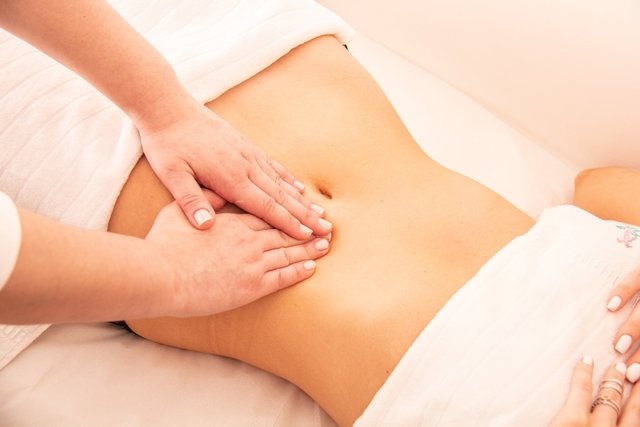Manual lymphatic drainage is a technique recommended to help the body eliminate excess fluids and toxins, facilitating the treatment of cellulite, swelling or lymphedema, and is also widely used in the post-operative period of surgery, especially plastic surgery.
This technique must always be carried out towards the lymph nodes, applying only a small pressure with your hands on the skin, as excess pressure can inhibit lymphatic circulation, compromising the results and, therefore, it is most recommended that it be done by a trained professional.
Drainage can be performed 1 to 5 times a week, according to need, and the number of sessions must be prescribed by the therapist who will perform the procedure, after an initial assessment.

Step by step to perform manual lymphatic drainage
To perform manual lymphatic drainage, the following steps must be followed:
1st step: breathe deeply
Breathing deeply helps to stimulate the lymphatic system throughout the body, and should be done by placing your hands on your stomach and inhaling the air deeply through your nose. Then exhale the air through your mouth slowly.
This step must be repeated 5 times, resting for a few minutes between breaths, to avoid causing dizziness.
2nd step: lymphatic drainage of the neck
Lymphatic drainage of the neck can be done on one side at a time or on both sides at the same time.
To perform lymphatic drainage in the neck you must:
- Place the index and middle fingers on the clavicle, making gentle movements towards the shoulder, covering the entire region over the clavicle, and repeat 15 times;
- Place one hand on each side of your neck, slide your hands down and then release. Repeat this movement 10 to 15 times;
- Place your hands on the back of your neck and gently slide your hands towards your spine. Then release and repeat this movement 10 to 15 times.
It is important not to apply too much pressure when making the movements, but only to perform gentle movements so that the lymphatic fluid in the neck area is drained.
3rd step: facial lymphatic drainage
After lymphatic drainage of the neck, facial drainage should continue, starting around the mouth. To do this, you must:
- Place the tips of your index and middle fingers on the center of your chin, making circular movements 5 to 10 times;
- Position your fingertips under your lower lip, sliding your fingers to the base of your chin;
- Place your fingers in the corner of your mouth, and with circular movements, slide your fingers to the center of your chin;
- Place your fingers between the base of the nose and the upper lip, and with circular movements, slide your fingers around the lips to the center of the chin;
- Position your fingers in the temple region, on the side of the face, and with circular movements, slide your fingers from the outer corner of the eye to the back of the ears;
- Place your fingers on the upper eyelid and, using circular movements, direct the lymph towards the ears. Do the same with the lower eyelids.
- Stimulate the auricular ganglia, close to the ear, making circular movements;
Then, make circles with your fingers (ring, middle and index) pushing the lymph from the cheeks towards the angle of the jaw. The movement starts at the bottom of the cheek, up to the angle, and then comes closer to the nose, bringing the lymph towards the angle;
See the video below for more details on how to perform lymphatic drainage on the face:
4th step: lymphatic drainage in the arms and hands
Draining the arm, hand and fingers begins with stimulation in the axillary region, with several series of 4 to 5 circles. Next you must:
- Make a sliding or wrist movement from the elbow to the armpit region. Repeat 5 to 7 times;
- Make sliding or wrist movements from the wrist to the elbow. Repeat 3 to 5 times;
- Close to the wrist, movements must be performed with the fingertips in circular movements;
- Hand drainage begins with circular movements from the region close to the thumb to the base of the fingers;
- The fingers are drained with circles combined with the tips of the fingers and thumb along their length;
Drainage of this area ends with stimulation of the axillary nodes.
5th step: lymphatic drainage of the chest and breast
Lymphatic drainage of the chest and breast should be done as follows:
- Position the palm of your hand over your armpit and slide your hand towards your body. Repeat 10 to 15 times;
- Position your fingers with circular movements, the area under the breast should drain towards the armpit. Repeat 5 to 7 times;
- Place your hand on your hip and make circular movements with your hand;
- Slide the hand that is on your hip, upwards towards your armpit, 10 to 15 times;
- Place the palm of your hand in the center of your chest and slide it upwards towards your collarbone, 5 to 7 times.
Drainage of this region ends with stimulation of the subclavicular region.
6th step: lymphatic drainage in the belly
Lymphatic drainage of the belly must follow the following steps:
- Place the palms of your hands below the hip crease and then slide your hands to the side and then upwards making circular movements. repeat 5 times;
- Make pressure movements with the side of your hand around the navel towards the iliac crest, and then from the iliac crest to the groin area. Repeat between 5 and 10 times on each side;
- Drainage from the side of the belly should be from top to bottom, gently pressing the skin until reaching the hip. Repeat between 5-10 times.
Drainage of the abdominal wall ends with pumping stimulation of the inguinal nodes.
7th step: lymphatic drainage in the legs and feet
Draining the legs and feet begins with stimulating the inguinal region with consecutive pressure and circular movements with the fingertips in several series of 4 to 5 circles. Next you must:
- Position the palms of your hands on the thigh and slide them from the middle of the thigh to the hips;
- Place the palms of your hands in the region closest to the knee, and gently slide them towards the inguinal region;
- The inner thigh region must be drained towards the genitals;
- Drainage of the knee begins by draining the popliteal nodes located at the back of the knee;
- Drainage from the back of the leg should always be towards the lymph nodes close to the genitals;
- Make bracelet movements from the ankle to the back of the knees, pressing your hands against the skin;
- Place your hands behind the bend of your knee and move up to your groin, passing through your buttocks.
All of these steps must be performed with the palm of your hands, and the movements repeated 5 to 10 times.
To drain the feet, you must make circular movements with the tips of your fingers from the malleolar region, which is the prominence of the ankle bone, to the back of the knee.
8th step: lymphatic drainage of the back and buttocks
The maneuvers performed on the back and glutes can include pressure with the side of the hand and circular movements with the fingers. To do this, you must perform movements in specific directions, such as:
- The middle of the back towards the armpit;
- The lumbar region towards the inguinal region (groin);
- The upper and middle region of the gluteus towards the inguinal region;
- The lower part of the glutes towards the genitals.
The drainage of this region ends with the stimulation of the inguinal ganglia, present in the groin.
9th step: rest
After completing the drainage, the person must remain lying down, resting for 5-10 minutes. If you are being treated for lymphedema, for example, you can wear an elastic sock or sleeve to prevent the area from becoming swollen again.
If you are going to perform intense physical activity next, you should also wear the compression sock or sleeve during the physical activity.
Types of maneuvers used
There are several maneuvers that can be performed during a drainage session, but the most used are:
- Finger circles (without thumb): circular movements are made by lightly pressing the skin and circles are made several consecutive times over the area of skin to be treated;
- Pressure with the side of the hand: Position the side of your hand (little finger) over the area to be treated and rotate your wrist until the other fingers touch the skin. Perform this movement repeatedly throughout the region to be treated;
- Slip or Bracelet: It is most commonly used on arms and legs or places where it is possible to wrap your hand around it. You must close your hand over the region to be treated and press the area with a slight dragging movement, starting from the region closest to the ganglia and moving away;
- Pressure with the thumb, with a circular movement: place only your thumb on the region to be treated and perform concentric circular movements, lightly pressing the skin consecutively in the area, without rubbing the region.
The pressure applied must always be gentle, similar to groping, and the drainage directions must be strictly respected to have the expected effect.
Bibliography
- UNIVERSITY HEALTH NETWORK. How to Do Lymphatic SelfMassage on Your Lower Body. 2020. Disponível em: <https://www.uhn.ca/PatientsFamilies/Health_Information/Health_Topics/Documents/How_to_Do_Self_Lymphatic_Massage_Lower_Body.pdf>. Acesso em 23 jun 2023
- MICHIGAN MEDICINE. Manual Lymphatic Drainage For Both Legs. 2020. Available at: <https://www.med.umich.edu/1libr/PMR/Lymphedema/BilatLEMLD.pdf>. Accessed on June 23, 2023
- MICHIGAN MEDICINE. Manual Lymphatic Drainage For Both Legs. 2020. Available at: <https://www.med.umich.edu/1libr/PMR/Lymphedema/BilatLEMLD.pdf>. Accessed on June 23, 2023
- LIN, Y.; et al. Manual Lymphatic Drainage for Breast Cancer-related Lymphedema: A Systematic Review and Meta-analysis of Randomized Controlled Trials. Clin Breast Cancer. 22. 5; e664-e673, 2022
- UNIVERSITY HEALTH NETWORK. How to Do Lymphatic SelfMassage on Your Lower Body. 2020. Disponível em: <https://www.uhn.ca/PatientsFamilies/Health_Information/Health_Topics/Documents/How_to_Do_Self_Lymphatic_Massage_Lower_Body.pdf>. Acesso em 23 jun 2023
- MAJEWSKI-SCHARGE, T.; SNYDER, K. The Effectiveness of Manual Lymphatic Drainage in Patients With Orthopedic Injuries. J Sport Rehabil. 25. 1; 91-7, 2016
- THOMPSON, B.; et al. Manual lymphatic drainage treatment for lymphedema: a systematic review of the literature. J Cancer Survival. 15.2; 244-258, 2021
- LIN, Y.; et al. Manual Lymphatic Drainage for Breast Cancer-related Lymphedema: A Systematic Review and Meta-analysis of Randomized Controlled Trials. Clin Breast Cancer. 22. 5; e664-e673, 2022
- MAJEWSKI-SCHARGE, T.; SNYDER, K. The Effectiveness of Manual Lymphatic Drainage in Patients With Orthopedic Injuries. J Sport Rehabil. 25. 1; 91-7, 2016
- LEDUC, Albert; LEDUC, Olivier.. Lymphatic Drainage: Theory and practice. 3rd edition. São Paulo: Manole, 2007.

Sign up for our newsletter and stay up to date with exclusive news
that can transform your routine!
Warning: Undefined array key "title" in /home/storelat/public_html/wp-content/plugins/link-whisper-premium/templates/frontend/related-posts.php on line 12
Warning: Undefined array key "title_tag" in /home/storelat/public_html/wp-content/plugins/link-whisper-premium/templates/frontend/related-posts.php on line 13




